Skimboarding Tips for Heavier Riders Over 200 lbs
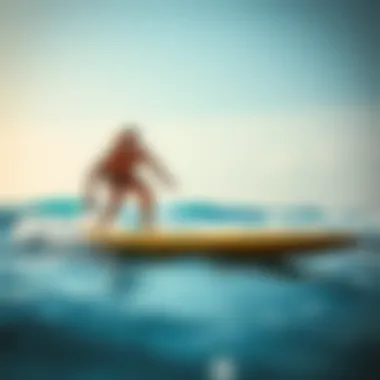
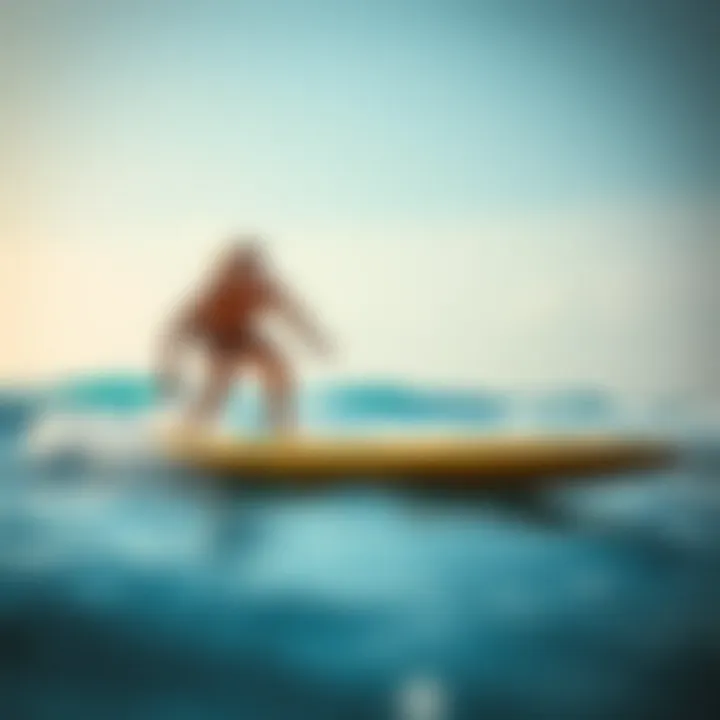
Intro
Skimboarding, an exhilarating sport where riders glide across the water's edge, offers a unique experience that varies significantly based on an individual's physique and skill level. For those tipping the scales at 200 lbs or more, there are distinct factors that weigh in—pun intended. Navigating the world of skimboarding as a heavier rider means considering board choice, riding techniques, and overall safety in ways that lighter counterparts might not face. The insights provided here aim to illuminate these nuances, giving heavier skimboarders the confidence to enjoy the rush while minimizing risks.
Surfboard Technology
To carve through the waves successfully, understanding the mechanics behind your skimboard is crucial. Choices in materials and shapes can significantly impact performance, especially for riders who carry more weight.
Innovations in Surfboard Materials
Today's skimboards come equipped with advanced materials that enhance durability and buoyancy. Boards constructed from fiberglass, epoxy, or even carbon fiber offer strength while keeping the weight down. This is particularly vital for heavier skimboarders, as the wrong material could lead to disappointing performance. Look for boards that feature a core with strong buoyant properties.
For instance, the addition of a high-density foam core can withstand the force of heavier riders, helping maintain stability and ease during take-off and landing. Some manufacturers are now even experimenting with a hybrid mix of materials that combine the advantages of each. These developments can help significantly in achieving better floatation and speed.
Comparing Different Surfboard Shapes
The shape of your skimboard doesn’t just influence how it looks; it can also dictate how it performs. Heavier riders might find specific shapes more accommodating. Here’s a breakdown:
- Fish Shape: Offers wider tails that provide better stability when getting up to speed. This type can help distribute weight evenly while maintaining maneuverability.
- Pin Tail: Known for speed, it's less forgiving but can perform well in more aggressive conditions for those who have experience.
- Hybrid Shape: As the name suggests, combines elements from different shapes, providing versatility and a balance that can suit various conditions.
Ultimately, choosing the right shape depends on your personal style and comfort level.
"The right board can make or break your skimboarding experience, especially for heavier riders who need that extra edge to stay afloat and stable."
Selecting a board tailored to meet your specific requirements can notably enhance your overall experience.
Skills for Beginners
As with any sport, the foundation of skimboarding starts with the basics. It's essential for heavier riders to develop a set of core skills that ensure steady progress and reduce the likelihood of injury. Some fundamental skills include:
- Balancing: Mastering how to distribute weight can drastically affect how you skim. Start on flat ground before moving to wavy water.
- Take-off Techniques: Practicing the right way to launch off the beach will also help you in gaining momentum and control.
- Turning: Work on carving turns, as this will aid in steering clear of obstacles and maintaining your speed.
On your journey to becoming proficient, patience will be your ally. It's more important to get the basics down solidly before attempting advanced maneuvers.
Advanced Maneuvers for Experts
Once you’re proficient, you might want to push your limits. Here, we delve into some advanced techniques that could elevate your skimboarding game:
- 360 Spins: These require a combination of speed and control. Practicing on softer sand can make the process less daunting.
- Slashing Turns: A quick switch in stance while carving through the water can unleash some exhilarating speed.
- Grabs and Aerials: As your comfort on the board increases, so does your capability to catch some air. Just ensure your landings are precise to avoid any nasty spills.
As with any sport, the thrill of skimboarding comes with challenges. But with the right techniques and a suitable board, heavier riders can overcome hurdles, allowing for an enjoyable experience on the waves.
For further reading on board materials and shapes, visit Wikipedia or check forums on Reddit.
Calculating your staying power on the board hinges on both equipment and skill sets. Begin with these basics before taking a leap into more daring tactics.
Understanding Skimboarding for Heavier Riders
Skimboarding can be an exhilarating experience, but for heavier riders, it involves certain unique challenges and considerations. Understanding the nuances tailored for individuals weighing over 200 pounds can make all the difference. This section sets the stage by delving into what skimboarding is and why it’s especially relevant for those who don’t fit the typical mold of riders.
Definition and Background of Skimboarding
Skimboarding originated in the surf culture of Laguna Beach, California during the 1920s. Originally, shapers crafted skimboards from wood, but today materials like foam and fiberglass dominate the market. Skimboarding is an athletic airborne activity that involves gliding on shallow water, typically near the shore. Riders run, drop the board onto the water’s surface, and then leap on it, attempting to glide as smoothly and swiftly as possible.
Understanding the roots and evolution of skimboarding adds context to its current practices. It’s vital to grasp the dynamics of how water interacts with the board and the rider, especially for heavier individuals. The mechanics of balance and momentum have to be taken into account along with the physics of the water’s surface beneath the board.
Relevance to Heavier Riders
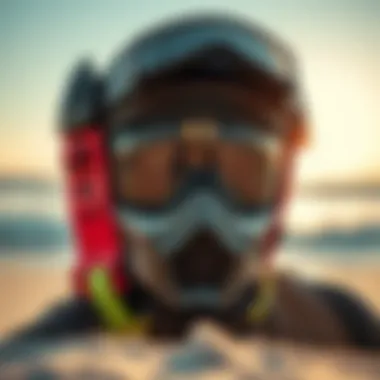

For heavier riders, skimboarding often comes with extra friction, both from the board and the water, which can lead to a different experience compared to lighter counterparts. Here are a few specific reasons why it matters:
- Weight Distribution: Heavier individuals may need to adjust their weight distribution while skimming to maintain stability on the board.
- Board Selection: Choosing the right board is crucial; boards designed with reinforced structures offer better support and performance.
- Hydrodynamics: Understanding how your weight affects speed and control can enhance your performance. Water dynamics change based on the weight of the rider, so knowing how to maneuver can be a game changer.
"The right approach to skimboarding can level the playing field for heavier riders. Adaptation and understanding make the waves much more welcoming."
In summary, grasping these essentials for heavier riders opens a world of possibilities. By evaluating the definitions and specific relevance of skimboarding, riders can better navigate their journey into this thrilling sport. Armed with this foundational knowledge, heavier riders can move forward confidently into the sections covering board selection and techniques.
Choosing the Right Skimboard
Selecting the right skimboard is crucial in enhancing the experience for heavier riders. The board can significantly influence not only performance but also safety and enjoyment on the water. The wrong board can make skimboarding feel clumsy or uncomfortable, while the right one ensures stability and control. For enthusiasts weighing 200 lbs or more, certain features and characteristics of a board become paramount.
Board Types Suitable for Heavier Riders
When it comes to the type of board, it's worth considering options that provide the stability and buoyancy needed for heavier riders.
- Standard Skimboards: These boards typically serve well for general use. However, they may lack the structural integrity required for heavier individuals, making them prone to cracking.
- Thicker Skimboards: Opting for a thicker board can provide extra flotation, helping to glide through the waves. Riders over 200 lbs should lean toward options with a greater surface area to accommodate their weight.
- Wider Designs: Boards with a broader width distribute weight more efficiently, enhancing stability during use. The added surface area can minimize the risk of the board sinking or tipping over.
A recommended choice is the BPS Skimboard, which combines thickness and width, making it a reliable option for heavier riders. Such boards help maintain control during rides on both flat surfaces and waves.
Size and Dimensions Considerations
Size plays a central role in overall performance.
- Length: A longer board helps maintain speed, while a shorter one aids in maneuverability. As a general rule, heavier riders should consider boards that are at least 48 to 52 inches long.
- Width: As mentioned, width aids in stability. A minimum width of about 20 inches is advisable, given that it provides better balance while skimming.
- Thickness: A thicker board can contribute to strength and flotation. A board with a thickness of approximately 0.75 inches is optimal for heavier riders, allowing for both durability and buoyancy.
Material Options and Their Impact
Not all skimboards are created equal; the material can greatly affect weight distribution, durability, and overall performance. Common materials include:
- Polyethylene: Often found in entry-level boards, polyethylene is lightweight but may not offer the longevity needed for heavier users.
- Wood: A solid choice known for its robustness. Wood boards tend to provide excellent weight support. However, they can be heavier, which might be a consideration when running to catch a wave.
- Fiberglass: These boards strike a balance, providing strength and a light profile. They resist water damage well and maintain shape, which is beneficial for consistent performance.
When selecting a skimboard, it's essential to consider how the material will impact your ride—especially if you're aiming for those epic waves. Many heavier riders find that fiberglass boards, such as the DB Skimboards, afford them both performance and durability without compromising on weight.
Techniques for Effective Skimboarding
Skimboarding, particularly for heavier individuals, requires a different approach compared to lighter riders. This section emphasizes how mastering specific techniques can significantly elevate the experience of skimboarding. As a heavy rider, being mindful of your weight and how it affects your boarding dynamics is vital. Every technique, from the basic maneuvers to the advanced tricks, is influenced by the rider's weight, making it essential to understand these unique elements. Improvements in your technique not only contribute to performance but also enhance safety and enjoyment on the water.
Basic Skimming Techniques
For newcomers and seasoned skimboarders alike, grasping the basic skimming techniques is paramount. These foundational skills serve as building blocks for more complex maneuvers later on. Here are some key techniques tailored for heavier riders:
- Reading the Wave and Shoreline: Understanding how different wave types affect glide is essential. Look for waves with a consistent break that allows sufficient speed.
- Weight Distribution: Maintaining a balanced stance while skimming is crucial. Stand with your feet about shoulder-width apart, and keep your knees slightly bent to absorb impact and maintain control.
- Launching Properly: To start, run toward the water, and as you reach the wet sand, place your skimboard down at a slight angle. Jump onto the board with one foot to ensure a solid grip before kicking off with your back foot.
Incorporating these basic techniques can greatly enhance your confidence in skimboarding. Mastery of these skills not only boosts your control but also lays the groundwork for advanced techniques.
Advanced Techniques for Heavier Riders
Once you feel comfortable with the basic skills, it's time to delve into more advanced techniques that can truly set you apart. These techniques may require practice but are well worth the effort:
- Power Slides: This move allows riders to maintain speed while making sharp turns. Initiate the slide by shifting your weight back as you turn, using your hips and shoulders to guide the board.
- Jumping the Shore Break: For those seeking adrenaline, learning how to jump over the waves can be exhilarating. Timing is key; just as a wave approaches, crouch low and jump. A well-executed jump can result in a smooth landing and continued ride.
- Tricks and Spins: As heavier riders, attempting tricks like 180s or 360s can be more challenging. Focus on building momentum first and twisting your body to guide the board. Always prioritize landing safely to avoid falls.
These advanced techniques may take time to master, but they open the door to a much richer skimboarding experience.
Tips for Managing Speed and Control
One of the biggest challenges heavier riders face is managing speed without sacrificing control. Here are several tips to help you strike the right balance:
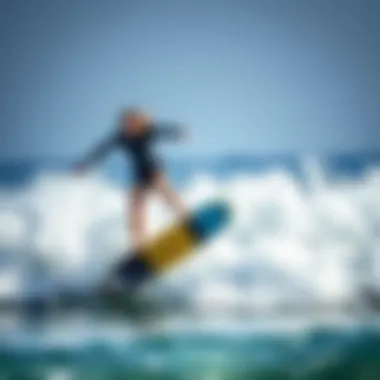

- Stay Low: Keeping a low center of gravity can improve balance and control, particularly during high-speed rides or turns.
- Brake with Technique: Utilizing your body weight to manage speed is essential. Lean back slightly when you need to slow down; this can help maintain traction while decreasing speed.
- Practice on Different Surfaces: Not all beaches offer ideal skimboarding conditions. Experimenting on various surfaces or wave types can improve adaptability and control.
With these tips, you’ll find that speed can be exhilarating while still maintaining a level of control that's not just necessary, but also safe. As you hone these techniques, you will likely notice a marked improvement in your overall skimboarding experience.
Safety Considerations
Safety is paramount for everyone participating in watersports, but it becomes even more crucial when discussing heavier riders in skimboarding. Riders who weigh 200 lbs or more face unique challenges and potential risks that aren’t as pronounced for lighter individuals. Understanding these factors not only enhances the skimboarding experience but can also significantly reduce the chance of injury. Being aware of the potential hazards, appropriate protective gear, and safe riding environments is essential for anyone looking to glide over the sand and surf.
Risks Unique to Heavier Skimboarders
Heavier skimboarders encounter specific risks which might not be as evident to their lighter counterparts. First off, the greater momentum generated by added weight can lead to more severe impacts when a wipeout occurs. A fall could result in harsher landings, increasing the risk of injuries like sprains, fractures, or even concussions if the head is hit against the ground.
Moreover, the dynamics of skimboarding change with weight. Heavier riders might experience varying performance issues, such as decreased buoyancy on the board or difficulty in controlling speed. These factors could make it more challenging to navigate tricky waters, or even more dangerous in crowded areas.
One mustn’t forget the added strain the board experiences under extra weight. A board that’s not designed to handle the weight can warp, leading to unexpected failures right when they’re needed the most. To put it bluntly: heavier riders need to be particularly vigilant about equipment integrity and personal safety measures.
Protective Gear for Enhanced Safety
Using the right protective gear can be a total game changer for heavier skimboarders. Here are a few essentials:
- Helmets: These should be a non-negotiable part of your gear. Even if you feel confident, accidents happen, and protecting your head from falls is key.
- Wrist Guards: Wrist injuries are common amid falls. Investing in padded wrist guards can save you a lot of pain, especially when you’re just learning or attempting new tricks.
- Knee Pads: Given the potential for knee impacts on hard surfaces, knee pads can be a lifesaver. They not only minimize injuries but also provide extra cushion during landings.
- Ankle Support: High-top shoes or specialized ankle braces offer additional support and can help prevent common ankle injuries.
"Safety is not just about avoiding 'what ifs'; it's about ensuring you enjoy the sport to its fullest without unnecessary risks."
Identifying Safe Locations for Skimboarding
Finding the right spot to skimboard can dramatically enhance the experience not just for heavy riders, but for anyone involved. For heavier riders, certain features of a location can either boost fun or pose risks.
- Sand Quality: Look for locations with soft, compact sand. Softer surfaces can provide a more forgiving landing, reducing the risk of injury.
- Wave Conditions: Choose areas where the waves are manageable. Overly powerful or unpredictable waves can be perilous, especially for heavier riders.
- Crowd Levels: It’s best to skimboard in less crowded areas. Fewer people mean reduced chances of collisions, and it gives more space to practice without the pressure of others around.
- Shallow Water Zones: Areas where the water is shallow near the shore will provide more opportunities to skim without fear of a sudden deep drop or unexpected currents.
- Environmental Conditions: Stay aware of weather forecasts. High winds or stormy conditions can negatively impact safety and performance.
To sum it up, having a solid grasp of potential risks, using appropriate protective gear, and scouting safe locations are all vital to enjoying skimboarding while minimizing hazards. This is especially true for heavier riders who have unique considerations that require extra precaution. As they say, it's not just about riding the waves but also riding them safely!
Skimboard Maintenance and Care
Taking care of your skimboard is not simply a choice, it’s a necessity, especially for heavier riders who put additional stress on their equipment. Proper maintenance ensures that your skimboard remains in top-notch condition, enhances its lifespan, and optimizes your performance on the water. By committing to a routine of cleaning and inspecting your board, you not only save money in the long run but also enjoy a better skimboarding experience.
Cleaning Your Skimboard
Regular cleaning of your skimboard is crucial to keep it functioning well. Sand, salt, and grime can accumulate on the surface and edges, affecting glide and speed. Besides, neglecting this vital step might lead to deterioration, which is the last thing a heavy rider wants.
To clean your skimboard:
- Rinse it immediately after use to get rid of saltwater and sand. A good practice is to use a hose at the beach or a bucket if you're at home.
- Use mild soap mixed with warm water to scrub the board with a soft cloth or sponge. Avoid abrasive cleaners as they can scratch the surface.
- Make sure to clean the underside thoroughly as it usually collects the most grit.
- Always dry the board completely with a towel before storing it to prevent any mold or mildew. Remember, a clean skimboard allows for smoother rides and reduces the risk of damage over time.
Regular Inspections and Repairs
Regular inspections play a pivotal role in ensuring your skimboard stays robust and ready for action. For heavier riders, the wear and tear can happen faster due to added weight. Implementing a check-up routine can help preserve the board’s integrity and improve performance.
Here are some essential aspects to look for:
- Surface checks: Look for cracks, delamination, or chips in the board. Catching these early can prevent further damage that might occur during riding.
- Edge condition: Ensure that the edges remain sharp and intact. A damaged edge can severely affect your ability to skim effectively.
- Fin and footpad assessments: If your board has fins, ensure they are securely attached and not cracked. Similarly, check footpads for wear. Replace them if they are losing grip.
- Repair minor issues immediately: If you notice small cracks, consider using repair kits available at skimboarding shops. These kits often come with resin and sandpaper, which allow you to perform quick fixes at home.
“Taking care of your skimboard is like nurturing a plant; neglect it, and it wilts.” Staying vigilant about checks ensures you surf the waves without worries, emphasizing safety and fun.
By incorporating a regular cleaning and inspection routine, you create an environment where your skills can flourish. A well-maintained skimboard not only performs better but also reflects your commitment to the sport. For further reading on the maintenance and care of skimboards, check out Wikipedia or visit forums like Reddit.
Gear Selection for Heavier Riders
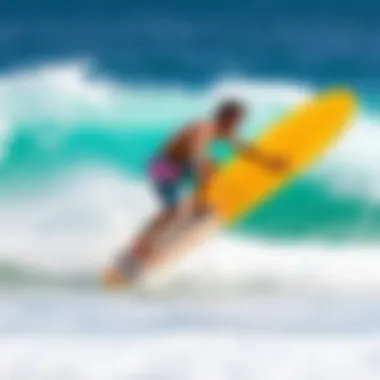
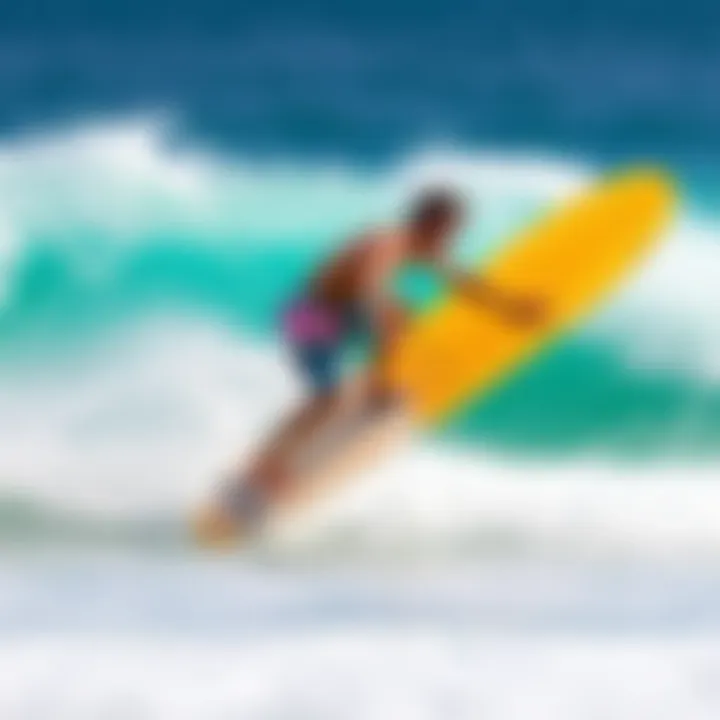
Choosing the proper gear is essential for heavier riders when it comes to skimboarding. This aspect is often overlooked, but it plays a critical role in enhancing performance and safety. Riders who weigh 200 lbs or more face unique challenges that can affect their ride. Therefore, selecting the right equipment is not just a wise choice; it’s a necessity. Moreover, appropriate gear can significantly impact one’s confidence on the board, potentially making or breaking the skimboarding experience.
Footwear and Its Importance
When it comes to skimboarding, the right footwear can't be emphasized enough. Heavier riders need shoes that can provide good grip and stability on the board. A sturdy pair of water shoes or specially designed skimboarding shoes will do wonders in improving traction on the wet surface, allowing for better control.
- Grip: A good sole made for slick surfaces prevents slipping. Consider brands like Quiksilver or O’Neill that focus on performance in wet conditions.
- Cushioning: Heavier individuals should look for footwear that offers cushioning and support to absorb shock. This is especially crucial for landing jumps or navigating through choppy waters.
- Durability: Since skimboarding can be demanding on footwear, invest in a pair that can withstand wear. Cheap shoes might save you money initially but often lead to higher costs in the long run.
Finding the right fit is also paramount. Skimboarding involves a lot of movement, and ill-fitting shoes can be uncomfortable and lead to blisters. It's worth spending time trying on various styles to see what fits best.
Clothing Choices for Comfort and Performance
What you wear while skimboarding can make a world of difference in comfort and performance. For heavier riders, it’s not just about aesthetic but also about functionality.
- Moisture-Wicking Fabrics: These materials, such as polyester or special blends, help to keep you dry by moving sweat away from the body. Staying dry means you'll have a better chance of maintaining your grip and focus while skimming.
- Board Shorts vs. Swim Suits: Board shorts can offer better mobility and are often designed with pockets, while fitted swim suits can reduce drag in the water. Test which one allows for greater freedom of movement in your own skimming routine.
- Layering Options: Depending on where you are skimboarding, you may need to consider layers. A light rash guard or a sun shirt can protect against sunburn, while a wetsuit may be necessary in colder waters.
"As winter approaches, a good wetsuit can be your best friend for skimboarding in chilly conditions."
In addition to the material, take into account the fit of your clothing. Loose-fitting garments may feel comfortable, but they can also lead to excess drag. Opt for clothes that hug your body just enough to disrupt as little water flow as possible.
Ultimately, gear selection for heavier riders encompasses footwear and clothing. Prioritizing performance and comfort can lead to a more fulfilling skimboarding experience. Skilled riders spend more time focusing on technique rather than discomfort, and that makes all the difference.
Additionally, resources like Wikipedia and Reddit might provide deeper insights and community experiences that complement your learning.
Choosing your gear wisely means you won’t just get out there, but you’ll also enjoy your time on the water. Happy skimming!
Community and Culture
In skimboarding, as in many outdoor sports, the community plays a pivotal role. For heavier riders, the collective spirit and inclusivity among skimboarders can enhance the experience significantly. Engaging with others not only helps to improve technical skills but also fosters a shared passion that can be deeply motivating.
The culture surrounding skimboarding is rich with diversity, drawing enthusiasts from various backgrounds who come together on the beaches and with boards in hand. This merging of experiences creates a dynamic social setting where heavier riders can find camaraderie and support. Networking with fellow skimboarders can lead to shared insights on techniques, gear, and locations that are particularly accommodating for those weighing 200 lbs or more. Commonly shared among seasoned skimboarders is the maxim that "the stronger the community, the smoother the ride.”
Connecting with Other Skimboarders
Building connections is crucial for any sport, especially for heavier skimboarders who may face unique challenges. Connecting with peers can happen in various contexts, from local beach gatherings to online forums.
Consider these ways to engage with the skimboarding community:
- Beach Meetups: Look for local events or informal gatherings where skimboarders gather. Such meetings allow riders to share experiences and tips in a relaxed environment.
- Social Media Groups: Join platforms like Facebook or subreddits dedicated to skimboarding. Sharing successes or struggles in these forums can provide insights and inspiration.
- Skimboarding Clinics: Some coastal areas offer clinics specifically catering to different skill levels. Participating in such a workshop can provide tailored advice whilst also meeting others who share your sport.
By mingling with both novice and expert skimboarders, heavier riders strengthen their skills and foster a sense of belonging.
Events and Competitions to Consider
The skimboarding scene is vibrant with organized events and competitions that can be particularly inspiring. Participating in or attending events can vastly improve skills and provide a platform for recognizing progress. Here are a few examples related to community and competition:
- Local Competitions: These often welcome riders of all sizes, giving heavier skimboarders the chance to find their footing and gain valuable experience. Look into any events hosted by beach towns or local skimboarding shops.
- National Championships: As riders progress, entering national contests can be an exciting challenge. While some may feel intimidated, these events usually encourage novice and experienced riders alike.
- Festivals: Various beaches host skimboarding festivals, celebrating the sport in a social atmosphere. These events often contain activities such as demos, workshops, and open riding sessions.
Engaging in these events reinforces community ties, boosts skills, and creates lasting memories that contribute to the broader culture of skimboarding.
Finale
In the realm of skimboarding, especially for individuals weighing 200 lbs or more, it's crucial to recap the essential elements that underpin a promising skimboarding experience. Skimboarding is not just a hobby; it's a sport that demands awareness, skill, and a careful approach to gear and safety. Heavier riders face unique challenges, and this article sheds light on how to navigate these with confidence.
Recap of Key Points
To distill the information presented:
- Understanding Skimboarding for Heavier Riders: Know that the core principles of skimboarding apply, but there are necessary adjustments based on weight, particularly in techniques and gear selection.
- Choosing the Right Skimboard: Selecting the ideal board depends on size, type, and materials. Heavier riders should opt for robust boards that offer better stability and strength.
- Techniques for Effective Skimboarding: Mastering both basic and advanced techniques is key for performance. Understanding speed management and control tailored to body weight cannot be overstated.
- Safety Considerations: Awareness of unique risks and the importance of protective gear is indispensable. Knowing where to skim and what to avoid can prevent unnecessary injuries.
- Gear Selection: Footwear and clothing matter significantly. Choosing the right items can enhance comfort and performance on the water.
- Community and Culture: Engaging with other riders and participating in events fosters a sense of belonging and enhances learning through shared experiences.
Encouragement for Commitment to the Sport
Skimboarding is an exhilarating sport, and those who embrace it can find immense joy and satisfaction. For heavier riders, it's about persistence and commitment. Building skills over time will lead to improvement and confidence. When you feel the rush of gliding across the water, it becomes clear why so many love this sport. Stick to it, learn, and don’t shy away from asking for tips from fellow skimboarders. The community is often welcoming, ready to lend a hand or offer advice.
If you're willing to invest time in mastering these skills and understanding your equipment, you'll undoubtedly reap the rewards. With each successful ride, you'll feel the fruits of your commitment. You don’t just skimboard; you become part of a vibrant lifestyle. So, strap on that board, hit the waves, and let your adventure unfold.



